
Legionella Guide
You will no doubt be aware that landlords now have a legal duty to ensure that the risk of exposure of tenants to legionella is properly assessed and controlled. However, what this means in practice has only slowly become clear.
Why manage the risk?
The first question many agents and landlords ask is why has this legislation been introduced. There have been few if any confirmed reports of tenants becoming ill or dying from Legionnaires Disease contracted from rented properties. However, there are two factors which have most likely led to the change in legislation.
Firstly, Legionnaires’ disease presents as pneumonia like symptoms, and people at a high risk from Legionnaires’ are also at a high risk from pneumonia. Therefore Legionnaires’ disease is not always diagnosed as the cause of illness or death and there are likely far higher instances of Legionnaires’ disease than are recorded.
Secondly, most instances of Legionnaires Disease are not fatal or serious enough for patients to seek medical attention. It can feel similar to having a bad case of the flu, and generally clears up in a short time. However, the impact of so many people falling sick from Legionnaires has a significant impact on the economy due to the level of sick days.
A recent outbreak of Legionnaires’ disease in Edinburgh ended with 4 people dead from the disease, 96 hospitalised and thousands more made ill. As well as seeking to prevent fatalities or serious illnesses, the legislation seeks to significantly reduce the number of people made ill each year from Legionnaires’ disease.
Managing the risk from legionella in rented properties requires a number of steps to be taken. Under health and safety legislation, the landlord is what is termed the Duty Holder, ie the person ultimately responsible for ensuring that legionella risk management takes place. The Duty Holder can appoint a Responsible Person to manage the risk from legionella, and in practice this will be their letting agent if they use one. See HSG 274 Part 2 para 2.138 onwards for the details of this.
What you need to do
The key actions which need to be carried out to manage legionella in rented properties are as follows:
- Have a legionella risk assessment carried out on the property by a competent person ie someone trained and qualified to do so.
- Implement appropriate measures to prevent or control risks from legionella in the property as recommended in the risk assessment.
- Inform tenants of their role in managing the risk from legionella and what actions they should be taking.
- Review the risk assessment periodically.
- Carry out ongoing management of the risk from legionella, including checking water temperatures at inspections, ensuring shower heads and hoses are regularly cleaned, and flushing water systems while properties are empty.
[toggles class=”yourcustomclass”]
[toggle title=”Choosing a Risk Assessor” class=”in”]
The first step in legionella risk management is carrying out a risk assessment on a property. This involves a risk assessor visiting the property and inspecting the hot and cold water systems. Each risk assessment should include an assessment of the risk, an asset register, a legionella control programme and a water system schematic.
When having a risk assessment carried out, it is important to ensure that the risk assessor is competent to carry out an assessment. The term “competent” comes from the health and safety legislation, and ACOP L8 para 49 explains what is meant as competent. Being able to demonstrate that the risk assessor is competent will be critical if you have to prove to the Health and Safety Executive that you have carried out your duties correctly.
To ensure a person is “competent”, you should always check that the risk assessor has attended a City and Guilds accredited training course to carry out legionella risk assessments. All of our risk assessors here at Legionella Edinburgh have attended City and Guilds accredited training.
Another clear sign of competency is for the contractor you are using to be a member of the Legionella Control Association (LCA). However, becoming a member of the LCA is quite expensive (over £1000), so you may find that companies that are LCA members don’t offer the best value for money. They are usually larger commercial companies that are focussed on providing legionella services to the commercial market, not the residential market, and therefore their costs are often higher.
Be aware that as well as carrying out a risk assessment contractors may suggest carrying out expensive testing or water sampling. This is only very rarely required on domestic properties, particularly those which are not supplied from the mains water system. With most domestic properties however this is not necessary, so don’t be duped into having these works carried out unless the contractor can give good reasons for doing so.
The risk assessment may identify aspects of the water system which require remedial works to reduce the risk of legionella, such as dead legs or cold water tanks which don’t meet current regulations. Inevitably most rented properties will have showers, so regular cleaning and de-scaling of showers and hoses will likely be part of the control programme.
[/toggle]
[toggle title=”Tell your tenants”]
As well as carrying out a risk assessment, tenants should be informed of the potential risk of exposure to legionella and its consequences, and what they should do to minimise this risk. A guidance note for tenants is included in our Landlord and Letting Agent packs. This should be sent to existing tenants when a risk assessment is carried out, and given to new tenants when they sign their tenancy agreement. Be sure to get new tenants to sign a copy for your records.
[/toggle]
[toggle title=”Reviews”]
Once a risk assessment has been carried out on a property, this needs to be reviewed periodically. There are a number of triggers for a review of the assessment. The following factors may require a review of the assessment;
- If there is a change to the water system or the way it is used by its occupants (ie replacing a hot water cylinder with a combi boiler, or installing a shower where previously there was none in the property)
- If there is a change to the use of the building where the system is installed (unlikely in rented properties but may occur eg if a property is split into studio flats)
- If there is new information available about risks or control measures
- If when testing the water temperature in the system hot water flows from outlets at a temperature below 50°C
- If when testing the water temperature in the system cold water flows from outlets at a temperature above 20°C
- If the current tenants or their visitors become at a high risk from legionella
- If there is a case of Legionnaires’ disease associated with the property
In the event of any of the above triggers occurring, the risk assessment should be reviewed by a competent person. If none of these triggers occur we recommend that risk assessments be reviewed at least every two years.
[/toggle]
[toggle title=”Manage the risk”]
The final requirement is to carry out ongoing management of the risk. There are a number of key management activities. The first is to check the condition of showerheads and hoses, along with water temperatures of both hot and cold taps, at periodic inspections of properties. Cold water temperatures should be below 20°C within two minutes, and hot water temperatures should be above 50°C within one minute. Showerheads and hoses should be clean and clear of scale.
The second management activity is to ensure that the water systems in a property are flushed on a weekly basis in the event that the property is left unoccupied. To flush a system, taps and outlets should be cracked open, not turned on fully, and left to run for ten minutes. Outlets should not be put on fully to avoid the creation of aerosol, which may contain bacteria. This should be carried out whenever a property is left unoccupied, for example between tenancies and during refurbishment.
The third management activity is to keep a record of all legionella risk management activities carried out on a property. If you would like a sample risk management record sheet just drop us an email and we’ll send you one.
[/toggle]
[/toggles]
Don’t panic
It may seem that managing the risk of legionella creates a lot of work. However, once you amend your working practices to accommodate the above recommendations, this will quickly become a normal part of managing a property. By making these small changes you can be confident that you have met the requirements of the Health and Safety Executive, and carried out your duties as the landlord.
If you have any questions, would like to book a risk assessment or want to arrange a free training session, just email info@legionellaedinburgh.com





